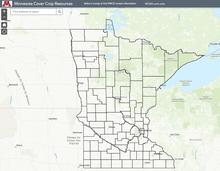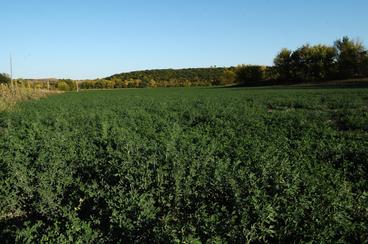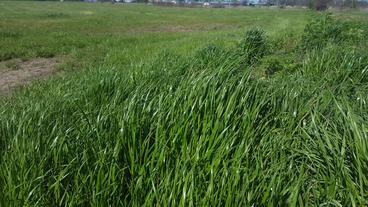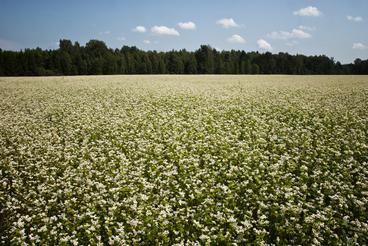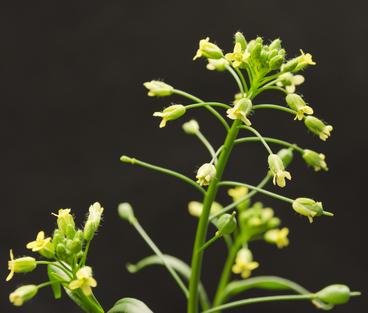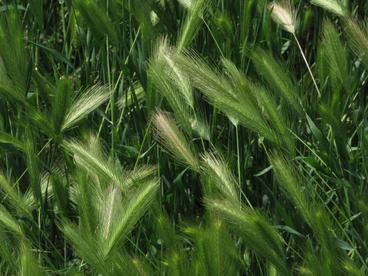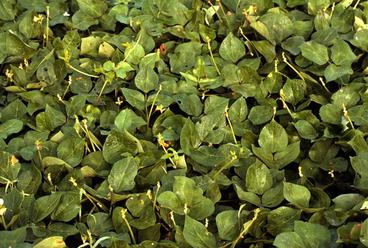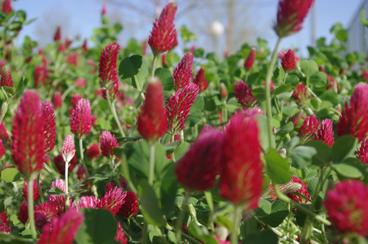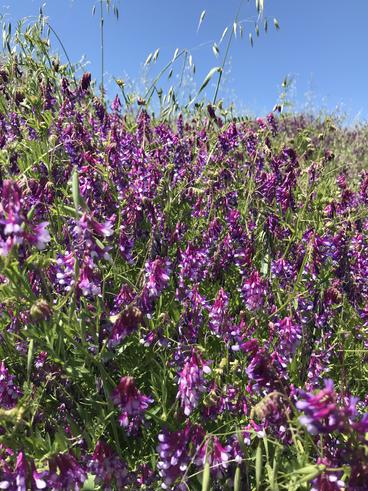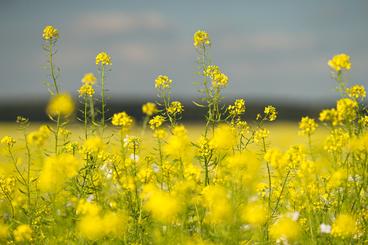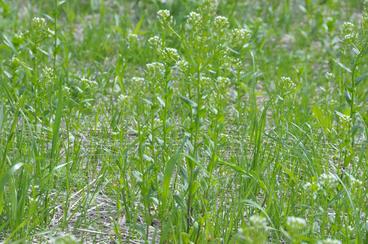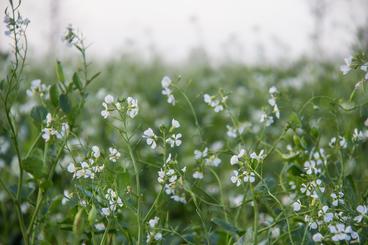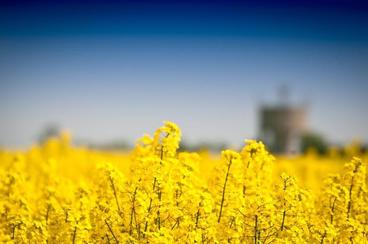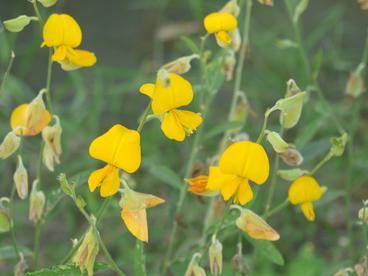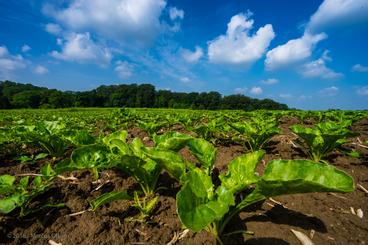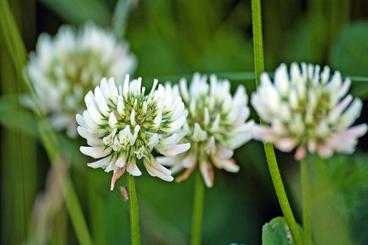Visit the Management page for more general information.
SWCD contacts and resources
A great place to learn is from someone who is growing cover crops. Visit your Soil and Water Conservation District to learn about local, state, and federal financial support for cover crops; other resources such as equipment rental; and to find individual producers or producer-led groups who can share their experience. Click on your county in this map to get contact information for your Soil and Water Conservation District.
Private-sector consultants
The NRCS directory of Technical Service Providers can be searched to find consultants certified by the NRCS to perform specific services related to Farm Bill programs.
Search for Certified Crop Advisors
These lists are provided for your convenience. No endorsement of individuals or companies by the University of Minnesota is implied.
Maps of cover crop use
major watershed, and sub-watershed.
These three maps show the percentage of agricultural land with cover crop growth in fall of 2019, summarized by county, major watershed, and sub-watershed. The information is based on satellite imagery taken after harvest and before snowfall. Ground-truthed samples are used during the process of interpreting the images to identify areas of live green vegetation. The Cropland Data Layer is used to remove areas identified as alfalfa, hay, forage, forest, grassland, and developed. The remaining green vegetation is assumed to be a cover crop. Areas without data lacked cloud-free satellite imagery during the post-harvest window. The University of Minnesota research team led by Dr. David Mulla continues to improve their method for interpreting satellite imagery, so results may change slightly in the future. In 2021, they expect to provide data from more years, an interactive map display, and options for data downloads. For more information, visit the Tillage and Erosion Survey Project on the BWSR website. The project is supported by the Clean Water Fund of the Clean Water, Land & Legacy Amendment.
of cover crops funded
by government programs.
This map was created using data compiled as part of a MN Pollution Control Agency web application called Best management practices implemented by watershed. It represents the number of acres enrolled in programs to incentivize cover crop planting including the Ag Water Quality Certification Program (MDA); EQIP and CSP (NRCS); and 319 and CWP programs (PCA). Data represent the total number of acres enrolled in all programs for a single average year. This is not comparable to the map of satellite-based data which represents the percentage of agricultural acres with visible cover crop emergence, regardless of program enrollment. For more data and explanation of the data, visit https://www.pca.state.mn.us/water/healthier-watersheds.
Minnesota cover crop research
The following pages summarize and interpret cover crop research in Minnesota and neighboring states. Only a few aspects of benefits and management have been studied, so you won’t find everything you’d like to know. Research is ongoing in a number of areas, including inter-seeding cover crops into standing corn and soybean, planting cash crops into green standing cover crops, incorporating cover crops into sugar beet rotations, and best practices for injecting manure into growing cover crops. Browse this list of University of Minnesota Extension cover crop work in progress to find names of Extension specialists working on cover crops.
Alfalfa (Medicago sativa L.)
Alfalfa (Medicago sativa L.)
Description
Alfalfa is a perennial legume that is suited to well-drained soils with near neutral pH and high fertility (SARE). Alfalfa fixes nitrogen, improving soil fertility. Recommended planting dates and termination methods for Minnesota are available from the MCCC decision tool and UMN Extension website.
Management
Alfalfa is not a good choice for poor soil conditions or clay soil. Alfalfa is suited to grow on well-drained soil with a pH around 6.5 to 7. Adjustment such as lime application may be necessary if soil is at a lower pH. Therefore, a soil test is recommended to successfully establish alfalfa.
Alfalfa can be included in the crop rotation to provide nitrogen to subsequent grain crops. UMN Extension recommends a planting date between July 25 and August 15 at 12 to 16 lbs/ac seeding rate. Seeding rate needs to be increased by 10 to 20 percent when using broadcast seeding (MSU Extension).
Seeding is typically done using a drill at ¼-½”, though it varies by soil type. If fewer than 10 seeds per square foot are showing on the surface, seeding is probably too deep (University of Wisconsin). Seed can also be broadcast with fertilizer and incorporated with a corrugated roller. Packing soil after seeding can help improve seed and soil contact.
Harvesting alfalfa helps remove phosphorus and potassium from the soil. Information from Michigan State University Extension suggests that each harvested dry matter ton of alfalfa removes approximately 11 pounds of P2O5 , 53 pounds of K2O, and about 5 pounds of sulfur. This information is also helpful prior to planting to determine nutrients needed in the soil.
Benefits
Enhance soil fertility
Alfalfa is very efficient in fixing nitrogen. It may fix 100-200 lbs of nitrogen per acre (New Mexico State University). No additional nitrogen fertilizer application is needed prior to planting. There hasn’t been field data in Minnesota to show the potential of nitrogen. Alfalfa has a relatively low C:N ratio (about 25:1), so it breaks down relatively quickly without tying up soil N.
Soil protection
Alfalfa has a very deep root system and a dense canopy. Both are beneficial to reducing soil erosion and loss of topsoil. When killed, it can be incorporated into the soil to increase nutrient availability.
Pest control
When alfalfa is interseeded into soybeans two weeks after planting soybeans, reduction of soybean cyst nematode by up to 55% may be expected (Chen et al., 2006). However, this effect might be due to the suppression of soybean growth.
Economics
Alfalfa can be harvested for forage after the first year.
Future Research Needs
Helpful topics that could be considered for future research include:
- Economics of alfalfa.
- How much nitrogen can be returned to the soil when incorporated and timing of release.
- Other benefits alfalfa provides, such as microbial community.
References
Alfalfa planting tips. FarmLifeTV, University of Wisconsin. 2018. Date of access: August 2019.
Chen, S., Wyse, D.L., Johnson, G.A., Porter, P.M., Stetina, S.R., Miller, D.R., Betts, K.J., Klossner, L.D., Haar, M.J. 2006. Effect of cover crops alfalfa, red clover, and perennial ryegrass on soybean cyst nematode population and soybean and corn yields in Minnesota. Crop Sci. 46, 1890-1897.
Cover Crop Decision Tool. Midwest Cover Crops Council. Date of access: August 2019.
Cover crop options. University of Minnesota Extension. Date of access: August 2019.
Nitrogen Fixation by Legumes. New Mexico State University. Date of access: August 2019.
Planting methods for successful alfalfa establishment. Michigan State University Extension. 2011. Date of access: August 2019.
Types of Cover Crops. Sustainable Agriculture Research & Education. Building Soils for Better
Crops, 3rd Edition. Date of access: August 2019.
Annual Rye (Lolium multiflorum)
Annual Rye (Lolium multiflorum)
Description
Annual rye, also known as Italian ryegrass or annual ryegrass, is a type of cool season annual grass. Annual rye is a relatively easy and cheap cover crop to grow that achieves the goals of reducing erosion, taking up soil nitrogen, and suppressing weeds.
Management
Annual rye grows best in fertile, well-drained loam or sandy loam soils. It can also grow in poor soil conditions, making it a very versatile cover crop choice. However, it does not survive severe winters (USDA NRCS).
UMN Extension recommends seeding 15-20 pounds per acre between July 10 and September 1.
Annual rye can be seeded with a no-till drill about ¼ to ⅜ inch deep. Mixing seed with fertilizer to broadcast and incorporate is also an option. Good seed and soil contact and a firm seedbed is good for germination. Since it is relatively shade-tolerant, it can be interseeded into corn or soybeans.
Aggressive growth makes annual rye a potential weed. A few tips for using herbicide for termination (Purdue Extension; Michigan State University):
- To ensure uptake, minimum air temperatures need to be greater than 45 F for three or more days after application;
- spray before annual rye reaches 8 inches tall and prior to seed head production;
- use a fullrate of herbicide application.
Yield impact
University of Wisconsin research indicates that interseeding annual ryegrass into corn at V5, whether alone, with red clover, or with red clover and forage radish, did not affect yield.
Benefits
Very limited research has been done in Minnesota to validate and quantify annual rye benefits. The benefits listed below are from various sources.
Soil protection
Annual rye has an extensive root system that makes it very efficient in preventing soil erosion. The establishment of annual rye is very fast to allow for quick ground cover.
Improve soil fertility
Annual rye’s extensive root system improves water infiltration and enhances soil tilth (SARE). Annual rye can also produce a large amount of biomass above ground that can build soil organic matter over time.
Weed suppression
Annual rye can act as a mulch and suppress early spring weeds if it’s able to produce large amounts of biomass before winterkilling.
Economics
Annual rye average seed price was $0.70/lb, as reported by 2 farms in 2016 (Lazarus and Keller, 2018). This report did not give a separate cost per acre for annual rye. However, an average cost per acre among annual rye, cereal rye, winter wheat, triticale and rapeseed was $25.58 per acre in 2016 and $20.24 per acre in 2017. Average cost for seed, equipment and labor came up to $43.93 per acre in 2016 and $36.80 per acre in 2017 (Lazarus and Keller, 2018).
Future Research Needs
- Seeding mix options
References
Annual Ryegrass Fact Sheet. USDA NRCS. 2003. Date of access: August 2019.
Annual Ryegrass. Sustainable Agriculture Research & Education. Managing Cover Crops Profitably, 3rd Edition. Date of access: August 2019.
Considerations for 2017 cover crop inter-seeding. University of Wisconsin- Madison. 2017. Date of access: August 2019.
Lazarus, W., Keller, A. 2018. Economic analysis of cover crops on farms participating in the southeastern Minnesota cover crop. 2018. University of Minnesota Extension.
Successful Annual Ryegrass Termination with Herbicides (PDF). Purdue Extension. 2015. Date of access: August 2019.
Tips for terminating an annual ryegrass cover crop. Michigan State University Extension. 2016. Date of access: August 2019.
Buckwheat (Fagopyrum esculentum)
Buckwheat (Fagopyrum esculentum)
Description
Buckwheat is a short-season grain crop. It establishes quickly and the residue breaks down quickly. Buckwheat is good for weed suppression and pollinators. It terminates easily and can extract soil phosphorus better than most grains (SARE).
Management
Buckwheat grows well in cool and moist conditions but it doesn’t tolerate frost. The UMN Extension website recommends buckwheat to be seeded between June 10 and August 15 at a rate of 45 to 60 lbs per acre. Buckwheat is suitable for sandy loams, loams, and silt loams. It does not grow well in heavy, wet soils or soils with high levels of limestone. Seed can be both drilled and broadcast. Broadcasting onto a firm seedbed with incorporation will help with seed and soil contact and allow better establishment.
The use of herbicides is effective for buckwheat termination. Termination prior to flowering is more effective as younger plant tissue absorbs herbicides more efficiently. Buckwheat has a relatively short time frame between flowering and seed production, so the timing of termination is particularly important (Michigan State University Extension). Mowing or frost are also easy ways to terminate buckwheat (USDA NRCS Plant Guide). However, mowing needs to cut the plant below all growing points and needs to happen no more than 10 days after plants begin to flower. Otherwise, the failed mowing might cause regrowth.
Buckwheat can potentially become a weed if the seeds are allowed to mature (USDA NRCS Plant Guide).
Benefits
Soil protection
Buckwheat establishes rapidly and easily, providing quick ground cover to prevent loss of topsoil (SARE). Plant residue also breaks down fast. Another crop may need to be planted to cover the soil.
Nutrient reduction
The dense and fibrous buckwheat root system provides large surface area in the top ten inches of soil for nutrient uptake. Buckwheat takes up phosphorus effectively.
Pest control
Few pests or diseases affect buckwheat growth. Buckwheat flowers require pollination or wind for fertilization (USDA NRCS Plant Guide). The flowers attract beneficial insects that attack or parasitize aphids, mites and other pests. The beneficials include hover flies, predatory wasps, minute pirate bugs, insidious flower bugs, tachinid flies and lady beetles (SARE).
Microbial community
Incorporating buckwheat residues into the soil can change the composition of the soil bacterial communities. Buckwheat can increase late season diversity in a field compared to a no cover crops field(Fernandez et al., 2016).
References
Buckwheat Plant Guide (PDF). USDA NRCS. Date of access: August 2019.
Buckwheat. Sustainable Agriculture Research & Education. Managing Cover Crops Profitably, 3rd Edition. Date of access: August 2019.
Cover crop termination (PDF). Michigan State University Extension. 2019. Date of access: August 2019.
Fernandez, A.L., Sheaffer, C.C., Wyse, D.L., Staley, C., Gould, T.J., Sadowsky, M.J. 2016. Structure of bacterial communities in soil following cover crop and organic fertilizer incorporation. Appl. Microbiol Biotechnol. 100, 9331-9341.
Camelina [Camelina sativa (L.) Crantz]
Camelina [Camelina sativa (L.) Crantz]
Description
Camelina, also known as winter camelina, is a winter-hardy broadleaf short-season crop. It is in the Brassica family. Like other Brassica species, camelina establishes fast and the residue breaks down fast. It is considered a weed in many areas and not commonly used in Minnesota as a cover crop, but it is under development as an oilseed crop.
Management
Limited information is available regarding camelina management as camelina is not very commonly used in Minnesota yet. No seeding rate is recommended for Minnesota specifically. PennState Extension suggested a seeding rate of 3-5 pounds per acre (PennState Extension, USDA NRCS Plant Guide). A Montana trial used a seeding rate of 2.5-3 pounds per acre. Drilling with packer wheels to ensure good seed to soil contact is ideal for establishment (USDA NRCS Plant Guide).
Camelina can be planted following corn stubble and is very frost-resistant. It has low soil fertility requirements, but responds to nitrogen, sulfur, and phosphorus fertilizer application.
It can be terminated by herbicide. Camelina is highly sensitive to the soil herbicide imidazolinones (USDA NRCS Plant Guide).
Benefits
Unlike other cover crops, camelina does not produce a high amount of residue to provide adequate soil protection for erosion control.
Nutrient reduction
Camelina picks up nutrients from the soil and reduces nutrient loss. Camelina is efficient in taking up nitrogen in soybean cropping systems (Thom et al., 2018; Johnson et al., 2017). When camelina grew to maturity after relay sowing of soybeans. In the spring, nitrate concentration was reduced in the camelina plot (10 mg/L) compared to the tilled plot (50 mg/L).
Weed control
Camelina competes with weeds, especially when established early. European research showed that camelina generates chemical compounds that suppress weed growth (PennState Extension).
Disease and insect control
Camelina is affected by few or no insects (PennState Extension). Camelina is resistant to white mold and blackleg, although these should still be monitored.
Pollinator
Camelina has pollinator friendly flowers. A camelina trial in Morris, Minnesota experienced high insect activity. High cumulative nectar production (100 kg of sugar per hectare) provided food resources to pollinators in early spring. (Eberle et al., 2015)
Future Research Needs
Winter camelina is being researched for double and relay cropping systems to identify appropriate planting dates to prevent competition for resources with the primary crops.
References
Camelina Production and Potential in Pennsylvania. PennState Extension. 2010. Date of access: August 2019.
Camelina Plant Guide (PDF). USDA NRCS. Date of access: August 2019.
Eberle, C.A., Thom, M.D., Nemec, K.T., Forcella, F., Lundgren, J.G., Gesch, R.W., Riedell, W.E., Papiernik, S.K., Wagner, A., Peterson, D.H., Eklund, J.J. 2015. Using pennycress, camelina, and canola cash cover crops to provision pollinators. Industrial Crops and Products. 75, 20-25.
Johnson, G.A., Wells, M.S., Anderson, K., Gesch, R.W., Forcella, F., Wyse, D.L. 2017. Yield tradeoffs and nitrogen between pennycress, camelina, and soybean in relay- and double- crop systems. Agron. J. 109, 2128-2135.
Thom, M.D., Forcella, F., Eberle, C.A., Matthees, H.L., Weyers, S.L., Gesch, R.W., Ott, M.A., Feyereisen, G.W., Strock, J.S., Wyse, D. 2018. Reduced-nutrient leachates in cash cover crop-soybean systems. https://doi.org/10.1101/254169.
Cereal Rye (Secale cereale L.)
Cereal Rye (Secale cereale L.)
Description
Also known as winter rye or grain rye, cereal rye is one of the most implemented and researched cover crops in Minnesota. Cereal rye is a winter-hardy cool-season annual grass and begins regrowth early in the spring (Stoskopf, 1985). It grows better on infertile, sandy or acidic soil than all other cover crops (Sustainable Agriculture Research & Education, SARE). Recommended planting dates and termination methods for Minnesota are available from the Midwest Cover Crops Council (MCCC) decision tool and UMN Extension website.
Management
Seeding and termination
Cereal rye is usually seeded in the fall after cash crop harvest. The recommended planting date from UMN Extension website is between July 10 and October 20. MCCC decision tool provides adjusted planting date per county.
Common planting methods for cereal rye include drill, broadcast (with or without incorporation). The drill method could potentially achieve greater fall biomass than broadcast for cereal rye (Noland et al., 2018). Precision planting is similar to drill but allows sensing and adjustment on a row by row basis. Precision planting can typically use fewer seeds. Drill and precision planting offer better seed-to-soil contact for effective germination compared to broadcast. Broadcast planting is a faster option and typically requires a higher seeding rate. Rate of establishment is usually comparable among different methods.
In the spring, rye can be terminated by herbicide, incorporation, or roller-crimping. A spring forage harvest is also possible (Krueger et al., 2011).
Challenges
Low rainfall and cool temperatures during the fall pose challenges to establishment. A combination of warmer than normal air temperatures and near-average precipitation in fall and spring is favorable to winter cover crop establishment and growth. Southwest Minnesota in the Lamberton area has moderately well-drained clay loam. The probability of favorable conditions for establishing and growing a cereal rye cover crop in this area is approximately 25% during a 41-year of records (Strock et al., 2004).
Yield impact
The impact of cereal rye on cash crop production varies by crop. Yield impacts are also influenced by cover termination, other crop stresses, and whether rye is harvested for forage (Krueger et al., 2011; Koch et al., 2015). It is likely the subsequent crop yield is reduced due to the uptake of soil water and nitrogen by cereal rye, however this can be managed by irrigation and application of fertilizer.
Benefits
Nitrogen reduction
Cereal rye accumulates a significant amount of biomass and takes up residual soil nitrogen, leading to lower nitrogen leaching losses following corn-soy rotations (Strock et al., 2004, Krueger et al., 2011, Feyereisen et al., 2006). Reduction of soil nitrogen down to 60 cm can be expected (Krueger et al., 2011; Noland et al., 2017), although highly variable: 13% to 84% (Krueger et al., 2010; Strock et al., 2004; Krueger et al., 2012).
Soil protection
Rye is likely to reduce loss of topsoil, however no Minnesota research has quantified this benefit. Although no research has been conducted in Minnesota, regional research showed that increased ground cover can also reduce soil erosion and increase soil organic matter. Cereal rye can build soil health, loosen top soil, and prevent erosion, particularly on sloping fields (SARE; Edwards et al., 1993).
Soil water retention
Water uptake by rye reduces soil moisture, thus potentially reducing the subsurface tile drainage. The soil moisture percent reduction with rye at the boot stage varies from 10% to 37% in the upper 60 cm compared to no rye (Krueger et al., 2010; Krueger et al., 2012). Cereal rye use in southern Minnesota and Iowa resulted in a tile drainage reduction of 11% and 9% over the course of 3 years (Strock et al., 2004; Qi & Helmers, 2010). However, no reduction in annual cumulative drainage was observed near Ames, IA (Kaspar et al., 2007; Kaspar et al., 2012). The soil near Ames, IA has a fine-loamy texture, similar to the sites that observed soil moisture reduction. The deviation in the results could be due to the precipitation of the study time period.
Weed control
The presence of cereal rye has different effects on different species of weeds. Rye reduced common lambsquarter and common cocklebur population nearly fourfold, but had no effect on giant ragweed and common ragweed. Use of herbicides in addition to rye improved with weed suppression. They concluded that rye did not provide adequate season-long suppression of all species. (DeBruin et al., 2005)
Cereal rye is often mixed with other cover crops to provide combined benefits and increase resilience of the cropping system. Leavitt et al. (2011) evaluated the use of cereal rye and hairy vetch in no-till production of tomato, zucchini, and bell pepper. In this study, weed density was greatly reduced (by 96%).
Insect pest control
Cereal rye can reduce insect pests. Planting soybeans into autumn-seeded rye cover crop reduced pest density greatly without adversely affecting soybean yields significantly (Koch et al., 2012; Koch et al., 2015).
Microbial community
Incorporating rye residues into the soil can change the composition of the soil bacterial communities. Early in the season, microbial diversity was reduced, while late-season diversity increased (Fernadez et al., 2016).
Economics
The cost of establishment and termination of cereal rye greatly limited the adoption. Although sequencing cash crop yield may not be affected with proper management, the profit is likely reduced. DeBruin et al. (2005) estimated the cost of using cereal rye and managing with mowing being $76 to $94 per hectare, compared to $60 per hectare with no rye and one-herbicide application.
Harvesting cereal rye as forage can help producers regain some cost. However, by depleting soil nutrients, cash crop yield may be suppressed.
Timing of cover crop termination can significantly affect subsequent yield as well. When rye was mowed early in the season with no additional herbicide application, regrowth of the cover crop competes with cash crop for soil moisture and nutrients (DeBruin et al., 2005).
Management options such as fertilizer application and irrigation can help improve yield of the subsequent crop (Leavitt et al., 2011; DeBruin et al., 2005). Cereal rye use in a vegetable crop system reduced vegetable yields in the first year; and with increased rates of fertilizer and more uniform application of water from the irrigation system, the second year yields of all vegetables were consistently higher than the first year (Leavitt et al., 2011).
Future Research Needs
Continuing research on cereal rye use in Minnesota will help gain a better understanding of the benefits and economics discussed above. Additional topics include disease suppression, farm profitability, and establishment. More information is needed in areas including:
- Herbicide interaction
- Risk management strategies
- Breeding research to make cereal rye work with cash crop better
- Market research
References
Cereal Rye. Sustainable Agriculture Research & Education. Managing Cover Crops Profitably, 3rd Edition. Date of access: August 2019.
Cover Crop Decision Tool. Midwest Cover Crops Council. Date of access: August 2019.
Cover crop options. University of Minnesota Extension. Date of access: August 2019.
De Bruin, J.L., Porter, P.M., Jordan, N.R. 2005. Use of a rye cover crop following corn in rotation with soybean in the Upper Midwest. Agron. J. 97, 587-598.
Edwards, W. M. et al. 1993.Tillage studies with a corn-soybean rotation: Hydrology and sediment loss. Soil Sci. Soc. Am. J. 57:1051-1055.
Feyereisen, G.W., Wilson, B.N., Sands, G.R., Strock, J.S., Porter, P.M. 2006. Potential for a rye cover crop to reduce nitrate loss in southwestern Minnesota. Agron. J. 98, 1416-1426.
Kaspar, T.C., Jaynes, D.B., Parkin, T.B., Moorman, T.B. 2007. Rye cover crop and gamagrass strip effects on NO3 concentration and load in tile drainage. J. Environ. Qual. 36, 1503-1511.
Kaspar, T.C., Jaynes, D.B., Parkin, T.B., Moorman, T.B., Singer, J.W. 2012. Effectiveness of oat and rye cover crops in reducing nitrate losses in drainage water. Agricultural Water Management. 110, 25-33.
Koch, R.L., Porter, P.M., Harbur, M.M., Abrahamson, M.D., Wyckhuys, K.A.G., Ragsdale, D.W., Buckman, K., Sezen, Z., Heimpel, G.E. 2012. Response of soybean insects to an autumn-seeded rye cover crop. Environ. Entomol. 41, 750-760.
Koch, R.L., Sezen, Z., Porter, P.M., Ragsdale, D.W., Wyckhuys, K.A.G., Heimpel, G.E. 2015. On-farm evaluation of a fall-seeded rye cover crop for suppression of soybean aphid (Hemiptera: Aphididae) on soybean. Agricultural and Forest Entomology. 17, 239-246.
Krueger, E.S., Ochsner, T.E., Porter, P.M., Baker, J.M. 2011. Winter rye cover crop management influences on soil water, soil nitrate, and corn development. Agron. J. 103, 316-323.
Krueger, E., Ochsner, T., Kantar, M., Sheaffer, C., Porter P. 2010. Growth stage at harvest of a winter rye cover crop influences soil moisture and nitrogen. Crop Management. Doi: 10.1094/CM-2010-1014-01-RS.
Krueger, E.S., Ochsner, T.E., Porter, P.M., Baker, J.M. 2011. Winter rye cover crop management influences on soil water, soil nitrate, and corn development. Agron. J. 103, 316-323.
Leavitt, M.J., Sheaffer, C.C., Wyse, D.L. 2011. Rolled winter rye and hairy vetch cover crops lower weed density but reduce vegetable yields in no-tillage organic production. HortScience. 46, 387-395.
Noland, R.L., Wells, M.S., Sheaffer, C.C., Baker, J.M., Martinson, K.L., Coulter, J.A. 2018. Establishment and function of cover crops interseeded into corn. Crop Sci. 58, 863-873.
Qi, Z., Helmers, M.J. 2010. Soil water dynamics under winter rye cover crop in central Iowa. Vadose Zone J. 9, 53-60.
Stoskopf, N.C. 1985. Rye. p. 403–414. In Cereal grain crops. Prentice Hall, Reston, VA.
Strock, J.S., Porter, P.M., Russelle, M.P. 2004. Cover cropping to reduce nitrate loss through subsurface drainage in the northern U.S. corn belt. J. Environ. Qual. 33, 1010-1016.
Cowpeas (Vigna unguiculata)
Cowpeas (Vigna unguiculata)
Description
Cowpeas are a legume which grows best in hot, moist zones. Cowpeas are resistant to drought and are able to tolerate heat. Like other legumes, cowpeas fix nitrogen and when incorporated, provide a good nitrogen source.
Management
Cowpeas should not be planted until soil temperature is consistently 65 F (SARE). UMN Extension recommends planting between May 20 and August 15 at a rate of 30 to 90 pounds per acre.
Cowpeas can be planted by both drilling and broadcasting. The higher end of the seeding rate should be used at cooler areas or for larger-seeded cultivars. When broadcasting, use a seeding rate of 100 pounds per acre (SARE). Incorporation will improve the seed and soil contact.
Incorporating cowpeas as green manure can increase soil nitrogen. Incorporation should happen when the entire crop is still green for quick release of the nutrient (SARE). Herbicides can be used together with mowing and rolling to terminate cowpea.
Benefits
Nitrogen fixation
Cowpeas can replenish soil organic matter and nitrogen. However, poor growing conditions and low biomass can both reduce the amount of N fixed by cowpea (University of Nebraska-Lincoln).
Pest management
Insects that are pests in commercial cowpea production have not been reported as problems when cowpeas are used as a cover crop (SARE).
Economics
Ohio State University Extension evaluated the economics of legume cover crop in 2010. They used a seed price of $0.80 per pound and concluded a total cost including seed, planting and termination of $46 to $54 per acre (Ohio State University Extension). Assuming 120-150 lb per acre of N were added by cowpeas, at a value of $60-$75, the system has a net gain of $6-$29 per acre.
Future Research Needs
Regional and Minnesota research on cowpeas is limited. Examining the amount of biomass and nitrogen produced by cowpea as well as the efficiency of terminating cowpeas with mowing and rolling would be useful. Since cowpea is usually used in mixes, field trials should test different species mixes.
References
Cowpeas. Sustainable Agriculture Research & Education. Managing Cover Crops Profitably, 3rd Edition. Date of access: August 2019.
Hoorman, J.J. Economics of Cover Crops (PDF). Ohio State University Extension. Date of access: August 2019.
Is Nitrogen Fixation Oversold with Legume Cover Crops? (PDF) Daren Redfearn and Bruce Anderson. 2016. University of Nebraska-Lincoln. Date of access: August 2019.
Crimson Clover (Trifolium incarnatum)
Crimson Clover (Trifolium incarnatum)
Description
Crimson clover is an annual legume which is not winter-hardy. It’s commonly used in mixes as a winter or summer annual cover crop in rotation with vegetables or field crops (USDA NRCS). Its residue can be easily managed in the spring. It can serve as a green manure and suppress weeds with its fast growth.
Management
Crimson clover grows well in any type of well drained soil and thrives in cool and moist conditions once established (SARE).
UMN Extension recommends a planting date between July 25 and September 1 (or six to eight weeks before the average first frost date) at a seeding rate between 10 and 15 pounds per acre (UMN Extension).
Crimson clover can be terminated mechanically by mowing or with herbicides after early bud stage (SARE). In colder regions, it can be winterkilled and provide mulch that can be disked or directly planted into in the spring (USDA NRCS). To maximize nitrogen availability to the following crop, it is recommended to wait three weeks before planting another crop to allow residue to break down (USDA NRCS).
Crimson clover has the potential to become weedy (USDA NRCS).
Benefits
Nitrogen fixation
Like other legume species, crimson clover is a good nitrogen source when incorporated into the soil contributing 70 to 150 lbs of nitrogen per acre (SARE). However, phosphorus deficiency and acidic soil with a pH less than 5 may limit the nitrogen fixation efficiency.
Habitat benefit
Crimson clover blossoms produce abundant nectar and provide a good source of food for various types of bees (SARE). The blossom may also contain bugs that prey on other pests (SARE).
Erosion control
The mulch created by crimson clover after winterkill provide ground cover that reduces the amount of topsoil loss in runoff events.
Future research needs
Evaluating the weedy potential of crimson clover in different regions in Minnesota would be useful. In addition, quantifying the nitrogen benefit from termination at different stages will be important to producers.
References
Cover crop options. University of Minnesota Extension. Date of access: August 2019.
Crimson Clover. Sustainable Agriculture Research & Education. Managing Cover Crops Profitably, 3rd Edition. Date of access: August 2019.
Crimson Clover Plant Guide (PDF). USDA NRCS. Date of access: August 2019.
Hairy Vetch (Vicia villosa)
Hairy Vetch (Vicia villosa)
Description
Hairy vetch is a winter or summer annual legume that produces a large amount of spring residue (SARE). Hairy vetch is commonly mixed with other cover crop species, such as cereal rye, buckwheat and/or radish.
Management
Both drilling and broadcasting works well for hairy vetch. Timely precipitation or irrigation helps with germination, especially when broadcast. The UMN Extension site suggests planting between July 25 and August 15 at a seeding rate between 15 and 25 pounds per acre. SARE site recommends a similar rate for drill and a higher rate of 25 to 30 pounds per acre for broadcasting. A soil pH between 6 and 7 with sufficient sulfur is necessary to ensure good germination. In Minnesota, vetch can be interseeded into corn at last cultivation (SARE).
Although hairy vetch can be helpful in weed suppression, some counties in Minnesota have avoided it due to the potential to become weedy. Specific regions should check for plant status to avoid invasive species (USDA NRCS).
Hairy vetch can be terminated mechanically or chemically 2 to 3 weeks prior to planting or sprayed at planting.
Benefits
Nitrogen fixation
As a legume species, hairy vetch can fix nitrogen. It can provide sufficient nitrogen for many vegetable crops, partially replacing nitrogen fertilizer for corn (SARE). Research showed that 59% or more of the vetch tissue nitrogen could be from atmospheric N fixation (Perrone et al., 2020).
Nutrient reduction
Hairy vetch is efficient in picking up phosphorus from the soil (SARE). Hairy vetch can also reduce the soil nitrogen level, although not as efficiently as winter rye (Noland et al., 2017).
Erosion control
Macropores created by hairy vetch allow more water to infiltrate into the soil profile and reduce runoff and loss of topsoil (SARE).
Weed suppression
Fast spring growth of fall-seeded hairy vetch out competes weeds (SARE). Residue from terminated hairy vetch also aids in weed suppression by shading the soil. Mixing rye and crimson clover with hairy vetch can extend the weed control to five or six weeks (SARE).
Compared to no cover crop, a winter rye-hairy vetch mix reduced average annual weed density by 96% for 8 to 10 weeds after roller-crimping in a St. Paul, MN trial of no-till vegetable production (Leavitt et al. 2011). However, the result was inconsistent in Lamberton, MN.
Future research needs
Hairy vetch is often used as part of a seed mix in varying proportions. Minnesota specific research could evaluate different seed mix options and quantify benefits provided by those seed mixes as well as impacts on cash crop yields.
References
Cover crop options. University of Minnesota Extension. Date of access: August 2019.
Hairy Vetch Plant Fact Sheet (PDF). USDA NRCS. Date of access: August 2019.
Hairy Vetch. Sustainable Agriculture Research & Education. Managing Cover Crops Profitably, 3rd Edition. Date of access: August 2019.
Leavitt, M.J., Sheaffer, C.C., Wyse, D.L. 2011. Rolled winter rye and hairy vetch cover crops lower weed density but reduce vegetable yields in no-tillage organic production. HortScience. 46, 387-395.
Perrone S., Grossman, J., Liebman, A., Sooksa-nguan, T., Gutknecht, J. 2020. Nitrogen fixation and productivity of winter annual legume cover crops in Upper Midwest organic cropping systems. Nutr Cycl Agroecosyst. 117:61-76.
Mustards (Brassicaceae)
Mustards (Brassicaceae)
Description
Mustard includes several species in the Brassicaceae family which establish quickly and takes up nutrients efficiently. It can produce large amounts of biomass and is also good for pest management (SARE). Mustard is often mixed with other Brassica species such as radish, turnip, or rapeseed.
Management
Mustard can be seeded by broadcasting. The UMN Extension site suggested a planting date between July 25 and September 15 for mustard at a rate between 4 and 8 lbs per acre. The fast-growing nature of mustard means it can potentially become a weed, although it generally winterkills in Minnesota.
Benefits
There hasn’t been a significant amount of Minnesota-specific research to provide field data for mustard implementation. However, benefits listed below are commonly seen.
Nutrient loss reduction
Nitrogen uptake by mustard varies with the biomass accumulation and the amount of N available in the soil profile (SARE). Mustard seeded in August produced 4,000-6,000 lb/ac of biomass and took up 85-105 lb/ac of N before winterkill (Gieske et al. 2015).
Pest management and weed control
Brassica species release chemical compounds that may be toxic to soil borne pathogens and pests like nematodes, fungi and some weeds (SARE). Mustard usually has higher concentrations of these chemicals.The fast growth of mustard can help with suppressing weeds. Incorporation of mustard will help the chemical compounds to be effective. For fall planted mustard, freezing and thawing may effectively macerate and release the chemical compound.
Erosion control
Ground cover by mustard will help reduce soil erosion. The shallow and extensive root system also is beneficial to reducing loss of topsoil.
Future research needs
SARE indicated that not enough research information was available regarding variables affecting the release and toxicity of the chemicals responsible for pest management. Because mustard is often mixed with other brassica species, more information on how the seed mix will perform in Minnesota’s specific climate conditions will be helpful.
References
Brassicas and Mustards. Sustainable Agriculture Research & Education. Managing Cover Crops Profitably, 3rd Edition. Date of access: August 2019.
Cover crop options. University of Minnesota Extension. Date of access: August 2019.
Gieske, M.F., Ackroyd, V.J., Baas, D.G., Mutch, D.R., Wyse, D.L., Durgan, B.R. 2016. Brassica cover crop effects on nitrogen availability and oat and corn yield. Agron. J. 108, 151-161.
Oats (Avena sativa)
Oats (Avena sativa)
Description
Oats are commonly used as a cover crop in Minnesota. Oats are a low-cost fall cover that winterkills in colder climates, providing a fairly low-risk introductory approach to cover-cropping (SARE, Midwest Cover Crops Council). When used in a seed mix, oats can help improve the productivity of legumes. Oats are good for suppressing weeds, taking up excess nutrients, and reducing erosion.
Management
Cool, moist conditions and well-drained soils are well suited for the growth of oats. The UMN Extension site recommends a planting date between July 10 and September 1 at a rate between 30 and 50 pounds per acre. Broadcasting, including overseeding into a senescing cash crop, with light incorporation will be the best if not seeded into heavy residue. Oats can also be planted by drilling or aerial seeding.
In Minnesota, low winter temperatures terminate oats more efficiently than herbicide (UMN Extension).
Benefits
Nutrient reduction
Oats can take up excess nitrogen and some phosphorus and potassium when planted early (SARE; Noland et al., 2017). Research in the upper Mississippi River basin observed a 26% reduction in nitrate concentrations when oats were planted into living corn and soybeans before harvest in late August or early September (Kaspar et al., 2012).
Pest management
Oats are less prone to insect problems than wheat or barley (SARE). Pests could be occasional problems if growing oats for grain or forage.
Weed suppression
Oat roots and residue contain allelopathic chemicals that hinder weed growth for a few weeks (SARE). Waiting three weeks before planting susceptible crops like wheat or peas can minimize the allelopathic effects of oats on subsequent crop germination.
Economics
The Ohio State University Extension evaluated the economics of cover crops in 2010. They used an oat seed price of $0.15 per pound and concluded the total cost of seed, planting and termination of $20 to $23 per acre is cheaper than other cover crops (Ohio State University Extension).
References
Hoorman, J.J. Economics of Cover Crops (PDF). Ohio State University. Date of access: August 2019.
Kaspar, T.C., Jaynes, D.B., Parkin, T.B., Moorman, T.B., Singer, J.W. 2012. Effectiveness of oat and rye cover crops in reducing nitrate losses in drainage water. Agricultural Water Management. 110, 25-33.
Minnesota Cover Crop Recipe – Post Soybean, Going to Corn: Use Oats. Midwest Cover Crops Council. Date of access: December 2019.
Noland, R.L., Wells, M.S., Sheaffer, C.C., Baker, J.M., Martinson, K.L., Coulter, J.A. 2018. Establishment and function of cover crops interseeded into corn. Crop Sci. 58, 863-873.
Oats: A Domesticated Weed. University of Minnesota Extension. Date of access: August 2019.
Oats. Sustainable Agriculture Research & Education. Managing Cover Crops Profitably, 3rd Edition. Date of access: August 2019.
Pennycress (Thlaspi arvense L.)
Pennycress (Thlaspi arvense L.)
Description
Pennycress is a winter annual oilseed crop, providing a winter cash crop while acting as a cover crop with benefits including erosion reduction, nutrient reduction and weed suppression. (UMN Forever Green).
Management
Drilled pennycress has a significantly larger number of established plants than broadcast plots at the same seeding rate (Phippen et al. DATE).
When used at a lower seeding rate in a seed mix with oat or radish, pennycress seed yield was reduced and pennycress plants were shorter at maturity compared to pennycress alone (Johnson et al., 2015). However, limited soil water can diminish pennycress growth in a mix as pennycress tends to have low water use efficiency (Johnson et al., 2015).
Benefits
Nutrient reduction
Planting pennycress into soybeans can help reduce inorganic soil nitrogen throughout the entire soil profile (Johnson et al., 2017; Thom et al., 2018). Soil nitrate reduction was 53% to 72% in the spring and 18%-19% in the fall, representing substantial decreases at the times of highest potential nitrogen loss (Johnson et al., 2017). Pennycress implementation after corn harvest can potentially provide nitrogen uptake of 15 to 28 kg N per ha (Moore et al., 2020).
Weed suppression
When pennycress was present, common lambsquarters, tall waterhemp, giant foxtail and green foxtail were significantly reduced (Eberle et al., 2015).
Pollinator
Pennycress has pollinator-friendly flowers. A trial in Morris, MN observed high insect activity with a maximum visitation rate of 67+/- 11.5 insects per minute and a nectar production of 13 kg of sugar per hectare (Eberle et al., 2015).
Future research needs
Pennycress is not frequently planted in Minnesota. Lack of field data makes it hard to make implementation decisions. In general, field trials that produce shareable data for seeding date, seeding rate, quantifiable benefits can help promote effective and profitable use.
References
Eberle, C.A., Thom, M.D., Nemec, K.T., Forcella, F., Lundgren, J.G., Gesch, R.W., Riedell, W.E., Papiernik, S.K., Wagner, A., Peterson, D.H., Eklund, J.J. 2015. Using pennycress, camelina, and canola cash cover crops to provision pollinators. Industrial Crops and Products. 75, 20-25.
Field Pennycress. University of Minnesota Forever Green. Date of access: August 2019.
Johnson, G.A., Kantar, M.B., Betts, K.J., Wyse, D.L. 2015. Field pennycress production and weed control in a double crop system with soybean in Minnesota. Agron. J. 107, 532-540.
Johnson, G.A., Wells, M.S., Anderson, K., Gesch, R.W., Forcella, F., Wyse, D.L. 2017. Yield tradeoffs and nitrogen between pennycress, camelina, and soybean in relay- and double- crop systems. Agron. J. 109, 2128-2135.
Moore, S.A., Wells, M.S., Gesch, R.W., Becker, R.L., Rosen, C.J., Wilson, M.L. 2020. Pennycress as a cash cover-crop: improving the sustainability of sweet corn production systems. Agronomy. 10, 614.
Phippen W, John B, Phippen M, Isbell T (2010b) Planting date, herbicide, and soybean rotation studies with field pennycress (Thlaspi arvense L.) (PDF). In: West. Illinois Univ. nts/PlantingDate2010.pdf. Date of access: August 2019.
Thom, M.D., Forcella, F., Eberle, C.A., Matthees, H.L., Weyers, S.L., Gesch, R.W., Ott, M.A., Feyereisen, G.W., Strock, J.S., Wyse, D. 2018. Reduced-nutrient leachates in cash cover crop-soybean systems. https://doi.org/10.1101/254169.
Radish (Raphanus sativus L.)
Radish (Raphanus sativus L.)
Description
Both forage radish and oilseed radish can be used as cover crops. Radish is a Brassica species. Like other Brassica species, radish germinates fast and has the potential to suppress weeds.
Management
Oilseed radish is more winter hardy than forage radish. Forage radish usually winterkills in Minnesota. Winterkilled forage radish leaves a nearly weed- and residue-free seedbed (Clark, 2007). UMN Extension recommends a planting date between July 25 to September 15 at a seeding rate between 8 to 15 pounds per acre (UMN Extension).
Benefits
Nutrient reduction
Radish has large taproot that can penetrate up to six feet to alleviate soil compaction, which allows more infiltration and nutrient uptake from deeper parts of the soil profile (SARE). Radish’s fast growth can also capture nitrogen in large amounts (SARE). When radish was planted in a corn rotation in Rosemount, MN, soil nitrate levels at the end of the fall cover crop growing season were lower in the radish plots than in the no-cover control plots, removing an average of 51 kg of nitrogen per hectare (Gieske et al., 2015).
Erosion control
The large taproot radish can help retain soil moisture and reduce erosion (USDA NRCS). The ground cover provided by the residue is also helpful in preventing topsoil loss, although radish residue is not as large or long-lasting as grass species.
Pest control
Radish and yellow mustard reduced the sugar beet cyst nematode populations by 19-75% in Wyoming (SARE). Rapeseed, radish and mustard blend did not significantly reduce incidence of soybean cyst nematode in Maryland (SARE).
Future research needs
Not enough data is available in quantifying radish effects on soil moisture, erosion rates, or cash crop yields.
References
Brassicas and Mustards. Sustainable Agriculture Research & Education. Managing Cover Crops Profitably, 3rd Edition. Date of access: August 2019.
Clark, Andy (ed.). 2007. Managing Cover Crops Profitably, 3rd ed. Sustainable Agriculture Network, Beltsville, MD.
Cover crop options. University of Minnesota Extension. Date of access: August 2019.
Gieske, M.F., Ackroyd, V.J., Baas, D.G., Mutch, D.R., Wyse, D.L., Durgan, B.R. 2016. Brassica cover crop effects on nitrogen availability and oat and corn yield. Agron. J. 108, 151-161.
Radishes: A new cover crop option (PDF). USDA NRCS. 2009. Date of access: August 2019.
Rapeseed (Brassica napus L.)
Rapeseed (Brassica napus L.)
Description
Rapeseed can refer to multiple Brassica species, including canola. Many rapeseed accessions are winter-hardy (Gieske et al., 2015). Rapeseed has deep taproots that are good for taking up excess soil nutrients and holding topsoil in place. Winter canola is under development as a cover crop in Minnesota, but has not been widely adopted.
Management
Clark (2007) suggests a rapeseed planting rate of 5-10 pounds per acre when drilled and 8-14 pounds per acre when broadcast seeded. The plant will grow three to five feet tall. UMN Extension website recommends a planting date between July 25 and September 15 at a rate between 2 to 5 pounds per acre. Application of nitrogen and phosphorus can improve winter survival of canola on some soils (Iowa State Extension). Iowa State Extension recommends the soil pH range to be between 6.0 and 7.0.
Winter-hardiness of rapeseed in St. Paul, MN, varied enormously from 7%-88% in 2010-2012 (Gieske et al., 2015). This is because rapeseed cultivars may be winter annual species, which can withstand temperatures to 32 F, or annual or spring-type species, so it is critical to ask seed dealers about the specific properties of anything labeled “rapeseed”. Depending on cultivar, rapeseed can be used as a spring or summer seeded cover crop or a fall seeded winter cover crop (Clark, 2007).
Terminating rapeseed with glyphosate may be difficult and a higher rate of at least 1 quart per acre is required (Clark, 2007).
Benefits
Nutrient reduction
Deep taproot of rapeseeds can efficiently take up soil nitrogen. The amount of soil nitrogen reduction is comparable to other Brassica species (Gieske et al., 2015).
Weed suppression
Like other Brassica species, the fast-growing rapeseed can outcompete weeds.
Erosion control
There is no research in Minnesota quantifying the erosion control by rapeseed. However, the deep taproot and fibrous shallow root can hold soil in place during runoff events.
Pollinator benefit
Winter canola flowers between late April and early June in the Northern Corn Belt (Eberle et al., 2015). The flowers provide ecosystem services to native insects and bees.
Future research needs
There is very limited research on the agronomics or economics of rapeseed as cover crop. Field trials in various soil conditions in Minnesota are needed to fill the knowledge gap.
References
Canola. Iowa State University Extension and Outreach. Date of access: August 2019.
Clark, Andy (ed.). 2007. Managing Cover Crops Profitably, 3rd ed. Sustainable Agriculture Network, Beltsville, MD.
Eberle, C.A., Thom, M.D., Nemec, K.T., Forcella, F., Lundgren, J.G., Gesch, R.W., Riedell, W.E., Papiernik, S.K., Wagner, A., Peterson, D.H., Eklund, J.J. 2015. Using pennycress, camelina, and canola cash cover crops to provision pollinators. Industrial Crops and Products. 75, 20-25.
Gieske, M.F., Ackroyd, V.J., Baas, D.G., Mutch, D.R., Wyse, D.L., Durgan, B.R. 2016. Brassica cover crop effects on nitrogen availability and oat and corn yield. Agron. J. 108, 151-161.
Red Clover (Trifolium pratense L.)
Red Clover (Trifolium pratense L.)
Description
Red clover is a winter hardy legume, designated for Hardiness Zone 4 and warmer (SARE). As a legume, red clover can fix a moderate amount of nitrogen, help suppress weeds and break up heavy soil (SARE). Red clover is often mixed with grain or grass species (USDA NRCS).
Management
Red clover is well adapted to various soil types and climates, preferring a soil pH range between 6.0 and 7.2 and cool conditions (SARE). Red clover germinates fast, in about seven days.
UMN Extension website suggested a planting date for red clover between July 25 and August 15 at a seeding rate between 8 and 12 pounds per acre. It can be drilled or broadcast.
Anthracnose and powdery mildew might be problems in areas with high humidity and rainfall (USDA NRCS).
For best nitrogen contribution, red clover should be terminated at about mid-bloom in spring of its second season (SARE). Red clover can be terminated mechanically in the spring by tilling, chopping or mowing anytime after blooming starts.
Benefits
Nutrient fixation
About 70% to 75% of nitrogen fixed by red clover was released in the first season in Wisconsin (Stute and Posner, 1995). No Minnesota specific information is available.
Soil improvement
Red clover can break heavy soil and improve topsoil structure (SARE; PennState Extension). It can also protect topsoil from erosion.
Pest control
Red clover, when interseeded into soybean at 0 and 2 weeks after planting, can reduce soybean cyst nematode by up to 40% (Chen et al., 2006). Yield impact in this study was only observed at one of the three locations (reduced by 38%)
Economics
The Ohio State University Extension evaluated the economics of legume cover crops in 2010. With seed at $2.00 per pound, they calculated the total cost of seed, planting and termination of $41 to $45 per acre (Ohio State University Extension). Assuming a nitrogen addition of 100-120 lbs per acre, they found that red clover provided a net gain of $5-19 per acre.
Future research needs
Evaluating the effectiveness and yield impact of delayed planting dates for red clover could provide useful information for using red clover to manage soybean cyst nematode (Chen et al., 2006).
References
Chen, S., Wyse, D.L., Johnson, G.A., Porter, P.M., Stetina, S.R., Miller, D.R., Betts, K.J., Klossner, L.D., Haar, M.J. 2006. Effect of cover crops alfalfa, red clover, and perennial ryegrass on soybean cyst nematode population and soybean and corn yields in Minnesota. Crop Sci. 46, 1890-1897.
Hoorman, J.J. Economics of Cover Crops (PDF). Ohio State University. Date of access: August 2019.
Management of Red Clover as a Cover Crop. PennState Extension. Date of access: August 2019.
Red Clover. Sustainable Agriculture Research & Education. Managing Cover Crops Profitably, 3rd Edition. Date of access: August 2019.
Red Clover Plant Fact Sheet (PDF). USDA NRCS. Date of access: August 2019.
Stute, J. K. and J. L. Posner. 1995. Synchrony between legume nitrogen release and corn demand in the upper Midwest. Agron. J. 87: 1063-1069.
Sunn Hemp (Crotalaria juncea L.)
Sunn Hemp (Crotalaria juncea L.)
Description
Sunn hemp is a fast growing nitrogen fixing legume that can provide additional benefits including erosion control, weed suppression, and soil tilth improvement. Sunn hemp has a long taproot with vigorous lateral roots (USDA NRCS).
Management
Sunn hemp is adapted to a variety of soil types and is well suited for well-drained soil with a pH between 6.0 and 7.0 (USDA NRCS). It is drought tolerant. Sunn hemp easily winterkills and should be planted a minimum of 9 weeks before the average date of the first fall freeze (Clark, 2007). USDA NRCS recommends sunn hemp seed to be inoculated with cowpea-type rhizobia and drilled at a rate of 30 to 50 pounds per acre, or proportionally lower when used in a seed mix. Adding phosphorus may help to increase yields of sunn hemp (Cook et al., 2005).
Benefits
Nutrient fixation
Sunn hemp can produce more than 5,000 pounds of dry matter per acre and 120 pounds of nitrogen per acre in 9-12 weeks of good growing conditions (Clark, 2007). When planted in the summer and mowed in the fall, rapid mineralization will occur during the winter to release nitrogen (USDA NRCS).
Pest control
Sunn hemp is a poor host for nematodes and produces allelopathic compounds that suppress sedentary plant-parasitic nematodes such as root-knot, soybean cyst, and reniform nematodes (Want and McSorley, 2009; USDA NRCS).
Economics
Sunn hemp only develops seeds in tropical regions. The biggest challenge to using sunn hemp is the seed availability (USDA NRCS).
Future research needs
Sunn hemp is being used in Minnesota. However, not much field data is available for sharing. Providing a platform where producers in different regions of Minnesota can share information will be helpful.
References
Clark, Andy (ed.). 2007. Managing Cover Crops Profitably, 3rd ed. Sustainable Agriculture Network, Beltsville, MD.
Cook, B.G., B.C. Pengelly, S.D. Brown, J.L. Donnelly, D.A. Eagles, M.A. Franco, J. Hanson, B.F. Mullen, I.J. Partridge, M. Peters, and R. Schultze-Kraft. 2005. Tropical forages: an interactive selection tool. Crotalaria juncea. CSIRO, DPI&F(Qld), CIAT, and ILRI, Brisbane, Australia.
Sunn Hemp Plant Guide (PDF). USDA NRCS. Date of access: August 2019.
Wang, K.H., and R. McSorley. 2009. Management of nematodes and soil fertility with sunn hemp cover crop. Publication #ENY-717. Univ. of Florida, IFAS Extension.
Turnip (B. rapa L. var. rapa L.)
Turnip (B. rapa L. var. rapa L.)
Description
Turnip is a Brassica species. It can alleviate soil compaction by producing bulbous taproots (SARE). Although turnip doesn’t produce as much biomass as the other Brassica species, the roots provide macrochannels that facilitate water infiltration (SARE).
Management
The UMN Extension website recommends a planting date of forage turnip between July 25 and September 15 and a planting rate of 1 to 4 pounds per acre.
Turnip can be terminated using a full rate of paraquat, multiple applications of glyphosate, or glyphosate plus 1 pt per acre 2, 4-D (SARE). Turnip can also winterkill in colder climates. Hybrid turnip (Brassica rapa L. X B. napus L.) planted in St. Paul, MN had a winter survival of 12% (Gieske et al., 2015).
Benefits
Soil health
Turnip has large taproots that can penetrate up to 6 feet to alleviate soil compaction (SARE). It’s the most effective when the soil is moist.
Nutrient reduction
Turnip can take up excess nitrogen from the soil. However, there is no research available to quantify this benefit in Minnesota.
Future research needs
Turnip is being used in Minnesota mixed with rye. Research or field trials that can quantify the benefit will provide useful information.
References
Brassicas and Mustards. Sustainable Agriculture Research & Education. Managing Cover Crops Profitably, 3rd Edition. Date of access: August 2019.
Gieske, M.F., Ackroyd, V.J., Baas, D.G., Mutch, D.R., Wyse, D.L., Durgan, B.R. 2016. Brassica cover crop effects on nitrogen availability and oat and corn yield. Agron. J. 108, 151-161.
White Clover (Trifolium repens L.)
White Clover (Trifolium repens L.)
Description
White clover is a perennial legume used as a winter annual. It is good for nitrogen fixation, erosion prevention and weed suppression. White clover will thrive under cool, moist conditions and shade (SARE).
Management
White clover grows best with plenty of lime, potash, calcium and phosphorus. It can tolerate poor conditions as well (SARE). UMN Extension website recommends a planting date of white clover between July 25 and August 15 at a planting rate of 5 to 8 pounds per acre. White clover can be terminated by thorough uprooting and incorporation. It can also be terminated in the spring with herbicide. Extremely close mowing and partial tillage that leaves any roots undisturbed will only suppress, not terminate white clover (SARE).
Although tolerant of nematodes and leaf diseases, white clover is susceptible to root and stolon rots, especially as stands age.
Benefits
Nitrogen fixation
White clover can produce 80 to 130 pounds of N per acre over the winter growing season. Since much of its total nitrogen is contained in the roots, partial tilling is effective in helping trigger nitrogen release. (SARE)
Erosion control
White clover grows in the shade, maintains a low profile and thrives when repeatedly mowed, making it ideal for living mulch system (SARE).
Future research needs
There is no Minnesota specific research information available yet. However, there is ongoing research on other legume cover crops. Minnesota’s short growing season, establishment and weed control are some top challenges. Ongoing studies seek to provide information on the most efficient rhizobia partner for improved nitrogen fixation and planting/harvest timing that maximize nitrogen delivery.
References
Cover crop options. University of Minnesota Extension. Date of access: August 2019.
White Clover. Sustainable Agriculture Research & Education. Managing Cover Crops Profitably, 3rd Edition. Date of access: August 2019.
